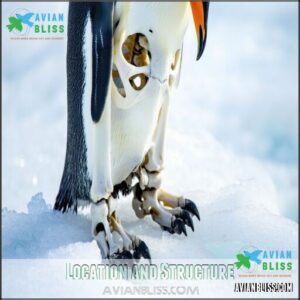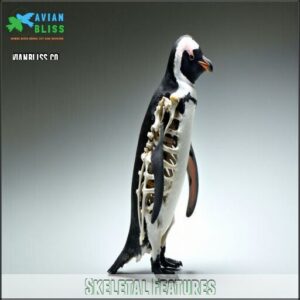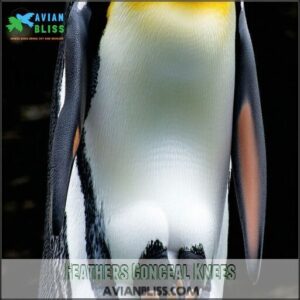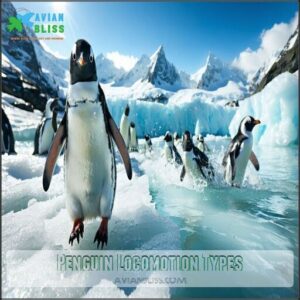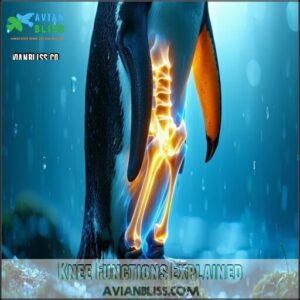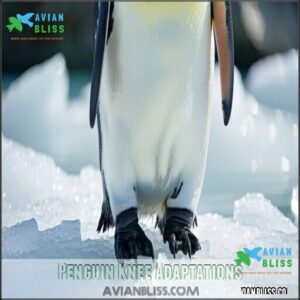This site is supported by our readers. We may earn a commission, at no cost to you, if you purchase through links.

This design helps them stay warm in icy climates. The knee joint connects the femur to the tibiotarsus and fibula, creating flexibility for swimming and waddling.
When they waddle, their knees bend just like yours, though hidden from view. It’s a clever adaptation for both land and water, even if it makes them look like they’re wearing invisible pants.
Curious about how this affects their movement in the wild? There’s plenty more to explore! Penguins have a unique way of moving, and understanding their knee joint is key to appreciating their agility.
Table Of Contents
- Key Takeaways
- Penguin Knee Anatomy
- Do Penguins Have Knees
- Penguin Leg Structure
- Knees Aid Movement
- Penguin Waddling Mechanism
- Feathers Conceal Knees
- Penguin Locomotion Types
- Knee Functions Explained
- Debunking Knee Myths
- Penguin Knee Adaptations
- Frequently Asked Questions (FAQs)
- Why do penguins not use their knees?
- Which animals don’t have knees?
- Do penguins have knees and elbows?
- Do penguins have knees, yes or no?
- Do penguins have kneecaps?
- What do Penguin legs look like?
- Why do penguins have a knee?
- Can you see a penguin’s knee?
- What is the anatomy of a penguin’s legs and knees?
- Do penguins have leg bones?
- Conclusion
Key Takeaways
- Penguins do have hidden knees, but they’re hidden under thick feathers, positioned high on their bodies to aid streamlined swimming and efficient movement.
- Their knees connect the femur, tibiotarsus, and fibula, playing a key role in their waddling gait and underwater propulsion.
- What looks like backward-bending knees is actually the ankle joint; the real knees are tucked inside, creating an optical illusion.
- Penguins’ hidden knees help them conserve heat, maintain balance on slippery terrain, and ensure agility in water.
Penguin Knee Anatomy
Yes, penguins have knees, but they’re hidden beneath layers of feathers, making them almost invisible to the eye.
Penguins have knees hidden under thick feathers, blending function and form to support their waddle and aquatic agility.
These knees are located high up on their legs, near their body, and consist of the femur, knee joint, tibia, and fibula, which work together to support both swimming and waddling.
Location and Structure
A penguin’s knee position often surprises people since it’s hidden high up, close to its body.
Thick feathers offer feather concealment, camouflaging joint components like the knee joint within the body’s sleek outline.
Unlike other bird knees, penguin anatomy keeps upper leg bones covered, forming unique leg proportions.
Heavy bone density supports movement on land and helps penguin legs stay hydrodynamic while swimming.
Skeletal Features
Penguin anatomy reveals fascinating skeletal features.
Their penguin legs boast dense bones for diving, supporting unique joint angles.
Bird knees, like theirs, include a cube-shaped patella tucked inside their muscular legs.
These hidden knee joints create a digitigrade stance, perfect for waddling.
The penguin skeleton accommodates both streamlined movement in water and stability on land, blending functionality with evolutionary design.
Feather Coverage
Most of what you see as a penguin’s “leg” is hidden beneath their dense, insulating feathers.
These feathers both keep them warm and waterproof their bodies, a must for swimming, and create smooth camouflage plumage around their knees, blending with icy environments.
Thanks to these bird adaptations, penguins maintain hydrodynamics while concealing their short legs, proving nature designs with purpose.
Do Penguins Have Knees
Believe it or not, penguins do have knees! Their seemingly stubby legs hide a complex structure high up their bodies.
X-ray confirmation shows knee joints, kneecaps, and leg proportions resembling human similarity. Their knees, tucked under thick feathers, aren’t visible externally, adding to common knee misconceptions.
Hidden within penguin anatomy, these joints bend like ours, aiding their unique waddling gait. Unlike other bird anatomy, penguin adaptations streamline movement, ensuring efficiency on land and water.
Their feathers are essential for waterproof and warm insulation. It’s a fascinating twist in penguin leg anatomy!
Penguin Leg Structure
You’ll find a penguin’s leg structure more complex than it appears, with a hidden femur, knee joint, tibiotarsus, and fibula tucked inside their bodies beneath thick feathers.
Their compact legs, positioned far back on their bodies, create that characteristic waddling gait you observe while providing the perfect streamlined shape for underwater efficiency.
Bones and Joints
Now that we’ve established penguins do have knees, let’s look at their bone structure.
You’ll find penguin leg anatomy features several specialized bones and joints.
Their skeletal evolution has produced denser bones than flying birds, which helps with underwater submersion.
Each leg contains a complex arrangement of joints with specific cartilage health requirements for flexibility.
The knee joint connects to other structures, creating a unique system optimized for both land and water movement, featuring denser bones and a complex arrangement of joints for underwater submersion.
Femur, Tibiotarsus, and Fibula
Looking beyond the joint structure, you’ll find three key bones forming a penguin’s leg anatomy.
The relatively short femur connects to the pelvis, while the tibiotarsus serves as the shin bone.
Unlike other birds, penguins possess a full-length fibula.
These bones have higher density than flying birds’, an underwater adaptation that reduces buoyancy.
This unique skeletal evolution optimizes joint mobility while maintaining the streamlined body shape you’d recognize from their characteristic waddle.
Function of Knees
Now that you’ve seen how a penguin’s leg bones work together, let’s understand what their knees actually do.
Penguin knees aren’t just anatomical features—they’re multifunctional marvels that help these birds survive.
Your penguin knee knowledge checklist:
- Provides stability and support during waddling
- Enables terrestrial locomotion across ice and rock
- Maintains proper incubation posture when protecting eggs
- Assists with thermoregulation by controlling blood flow
- Contributes to their streamlined swimming position underwater
Knees Aid Movement
You’ll find penguin knees maintain a vital 90-degree angle that guarantees a low center of gravity for their characteristic waddle while supporting their streamlined body shape.
These hidden joints help penguins regulate body temperature by controlling blood flow and enable energy-efficient movement across various terrains, from icy landscapes to rocky shores.
Propulsion and Thermoregulation
Two critical functions of penguin knees are propulsion and thermoregulation.
Their specialized leg structure enables efficient underwater propulsion while swimming, giving these aquatic birds remarkable hydrodynamic efficiency.
You’ll notice penguins also use their knees to control blood flow throughout their bodies, aiding heat conservation in frigid environments.
During incubation, their unique knee positioning supports the perfect posture needed for protecting eggs, proving that penguin biology has adapted beautifully for their challenging lifestyle with efficient thermoregulation.
Streamlined Body Shape
While penguins’ knees help regulate body temperature, they also contribute substantially to their streamlined body shape.
The tucked-in knee position reduces drag in water, giving these aquatic birds a hydrodynamic advantage during swimming.
Their specialized feather arrangement and body density, combined with the concealed leg structure, allow for remarkable underwater agility.
You’ll notice penguins’ apparently short legs aren’t a design flaw—they’re actually perfect for cutting through water with minimal resistance in penguin biology.
Penguins, like other birds, may also use a one-legged stance to conserve warmth.
Energy-Efficient Locomotion
Despite what you might think, a penguin’s knee structure contributes substantially to energy-efficient locomotion.
Their hidden joints allow them to conserve energy during their distinctive waddling gait on land while maximizing swimming economy underwater.
You’ll notice this amphibious movement adapts perfectly to their dual lifestyle.
The knee position minimizes resistance during aquatic locomotion, while on ice, tobogganing speed allows them to cover greater distances with less terrestrial energetics than walking.
Penguin Waddling Mechanism
You’ll notice penguins shift their weight from side to side as they waddle, using their hidden knee joints to maintain balance while conserving energy.
Their unique gait isn’t just adorable to watch but represents an efficient locomotion method that helps them navigate icy terrain with minimal effort, despite their legs being positioned far back on their bodies, which is a remarkable example of locomotion.
Energy-Efficient Gait
Beyond aiding movement, a penguin’s knees contribute to their remarkable waddling efficiency. You’ve probably noticed their distinctive side-to-side motion, which isn’t just adorable—it’s an engineering marvel.
Penguins achieve an incredible 80% energy recovery rate with their gait, outperforming humans’ 65%. This remarkable efficiency is partly due to how their penguin walk saves energy.
Here’s why their waddle works:
- Raises their center of mass effectively
- Compensates for short leg structure
- Maximizes mechanical energy recovery
- Overcomes physical limitations
- Maintains momentum on varied terrain
Rocking and Leaning Motion
Watch penguins closely and you’ll notice their distinctive rocking and leaning motion is actually a sophisticated balance control mechanism.
As they waddle, they shift their gravity center from side to side, creating a pendulum-like movement that conserves energy.
This unique gait adapts to various terrain impacts – whether ice, rock, or snow, and is both functional and charming.
Momentum and Gravity
The physics behind penguin locomotion relies on clever use of momentum and gravity.
When you watch penguins waddle, they’re actually employing sophisticated balance control techniques.
Their distinctive gait follows four key principles:
- Forward leaning creates gravitational pull
- Side-to-side rocking builds waddle momentum
- Minimal energy expenditure on incline walking
- Body weight shifts maximize forward motion
This efficient system helps penguins conserve precious energy while traversing their challenging environments.
Some birds even use a one-legged stance to conserve energy, which is a result of their sophisticated balance control and understanding of gravity.
Feathers Conceal Knees
You’ll find a penguin’s knees tucked inside their bodies, completely hidden by a thick layer of insulating feathers that create their characteristic stocky appearance.
The dense plumage that conceals their knees serves the dual purpose of maintaining body heat in frigid environments and creating a streamlined shape that reduces water resistance during swimming.
Concealed Knees
You’re looking at a penguin’s body and seeing what appears to be tiny legs without knees – but that’s a feathers illusion!
Their knees are there, just hidden beneath layers of insulating plumage. This optical deception has spawned widespread misconceptions about penguin anatomy.
While knee visibility is non-existent to casual observers, X-ray confirmation reveals fully-formed knee joints tucked close to their bodies.
The short legs in penguins aren’t actually that short; they’re simply concealed. Scientists studying penguin facts have documented how this clever anatomical arrangement serves their leg function perfectly.
Next time you spot a waddling penguin, remember – those knees are there, just playing hide-and-seek!
Adaptation for Environments
While penguins’ concealed knees might seem like an odd quirk of nature, they’re actually brilliant adaptations for their harsh environments.
In Cold Climate conditions, tucking knees inside their bodies helps these flightless birds conserve precious heat.
This internal knee placement also creates a Streamlined Shape that reduces drag when swimming, allowing penguins to withstand Underwater Pressure while hunting for their Dietary Needs.
You’ll notice that despite Terrestrial Challenges, their hidden joint structure enables their distinctive waddling gait across ice and rocky shores.
This unique aspect of animal locomotion represents one of many fascinating penguin facts—their bodies evolved specifically to handle both freezing temperatures and deep-sea diving with remarkable efficiency.
Penguin Locomotion Types
You’ll notice that penguins employ three distinct locomotion methods – waddling on land, tobogganing over ice and snow, and porpoising through water – all made possible by their hidden knee joints.
Their unique skeletal structure allows them to shift between these movement styles efficiently, conserving energy while traversing their challenging environments, making their locomotion methods a key aspect of their survival.
Waddling and Running
While those hidden knees remain tucked away, you’ll notice that penguins have a distinctive waddle mechanics when moving on land.
Their waddling gait isn’t inefficient—it’s actually perfect for energy conservation across varied terrain impact.
When necessary, some penguin species can reach a running speed of 5 mph, though they prefer their signature side-to-side motion, which helps them maintain balance despite having their knees positioned close to their bodies.
Tobogganing on Snow
Many penguins utilize tobogganing—sliding on their bellies across snow and ice—as their preferred method of travel on slippery terrain.
You’ll notice they propel themselves by pushing with their feet and flippers, reaching speeds far greater than waddling permits.
This belly gliding technique isn’t just fun to watch; it’s an effective adaptation for traversing icy habitats while minimizing injury risks from falls that can occur during upright locomotion on challenging terrain.
Tobogganing penguins often require specialized gliding equipment to facilitate their movement, making them well-adapted to their environment with the use of specialized equipment and effective adaptation.
Energy Expenditure
Despite appearances, penguins’ waddling is remarkably energy-efficient.
You might think their awkward gait wastes energy, but it actually conserves it.
Their hidden knees contribute to locomotion that uses about half the energy of similar-sized animals traveling the same distance.
Swimming costs less energy than land movement, while thermoregulation impact varies by species.
During incubation and molting demands, penguins minimize movement to conserve precious energy reserves.
Knee Functions Explained
You’ll find that penguin knees function much like your own, connecting the femur to the tibia and enabling essential movements for both land and water locomotion.
Their specialized knee joints remain tucked inside their bodies, hidden beneath feathers, providing structural support while contributing to their streamlined shape that reduces swimming resistance.
Specialized Knee Structure
Moving beyond different types of movement, let’s examine what makes penguin knees truly special.
The specialized knee structure of penguins features a cube-shaped patella (kneecap) unlike other birds.
Their joints show remarkable bone density—heavier than flying birds—which helps with underwater submersion.
Joint flexibility is limited but purposeful, with specific muscle attachment points that support their unique walking style.
This cartilage composition and overall anatomy perfectly suits their amphibious lifestyle, balancing land stability with swimming efficiency, which is made possible by their unique joint structure.
Knee Joint Structure
The anatomy of a penguin’s knee joint reveals fascinating engineering by nature.
Their joints contain a cube-shaped patella that’s unlike most animal knees you’re familiar with.
- Bone density in penguin knees exceeds that of flying birds, helping with underwater submersion
- Cartilage composition provides flexibility while maintaining joint stability
- Ligament strength supports their unique waddling locomotion
- Joint flexibility allows for the constant bent-knee position they maintain, which is a result of their unique anatomy.
Comparison to Birds
Like other birds, penguins share fundamental knee anatomy despite their unique aquatic lifestyle.
You’ll find their joint structure remarkably similar to their flighted ancestors, though adapted for swimming rather than flying.
| Feature | Penguins | Other Birds |
|---|---|---|
| Patella | Present | Present |
| Joint Structure | Modified for swimming | Optimized for landing |
| Visibility | Hidden under feathers | Often visible when perched |
| Evolution | From seabird relatives | Varied avian anatomy |
Unlike ratites, penguin skeletons evolved from flying birds, explaining their distinct bird biology.
Debunking Knee Myths
You’ll be surprised to learn that what you’re seeing isn’t a penguin’s knee bending backward, but actually its ankle joint visible outside its body.
Contrary to popular belief, penguin knees function similarly to human knees and remain hidden inside their bodies, covered by feathers that create their distinctive streamlined shape.
Knees Do Not Bend Backward
You’ve likely heard that penguins’ knees bend backward – but that’s not actually true.
What you’re seeing is their ankle joint, not their knee. The anatomical arrangement of penguin legs creates this illusion.
Their actual knees function just like yours, bending forward, but they’re hidden beneath feathers higher up on their body. This joint misconception stems from the unique proportions of bird legs compared to mammals, which can lead to a misunderstanding of their anatomical arrangement.
Knees Aid Propulsion
Within the water, penguin knees function as essential pivot points for powerful propulsion.
They flex and extend during swimming, generating underwater thrust that propels these birds through ocean currents.
You’ll find that this knee movement, working with their flipper-like wings, creates remarkable swimming efficiency.
Their knee hydrodynamics contribute substantially to their streamlined swimming capabilities, allowing penguins to achieve impressive speeds and underwater maneuverability despite their seemingly awkward terrestrial appearance.
Birds also have a hidden knee essential for locomotion.
Unique Adaptations
Beyond just aiding propulsion, penguin knees showcase remarkable adaptations.
Their streamlined shape allows these flightless birds to cut through water with minimal resistance during aquatic locomotion.
You’ll notice penguins practice digitigrade walking, standing on their toes rather than flat feet, improving terrestrial stability on ice.
Their knee positioning contributes to energy conservation too – penguins use about half the energy of similar-sized animals when traveling the same distance.
Penguin Knee Adaptations
You’ll notice penguin knees have evolved specifically to balance life between land and sea, with joints positioned higher in their bodies for ideal swimming efficiency.
Their uniquely adapted knee structure allows them to maintain stability on ice while also enabling their streamlined shape underwater, proving that nature’s engineering can solve multiple challenges at once.
Evolutionary Changes
Throughout millions of years, penguin knees evolved from ancestors with flight capabilities to their current specialized form.
DNA evidence shows these flightless birds developed denser bones and reshaped leg structures specifically for marine adaptation.
You’ll find that their knee positioning shifted higher in the body, creating the streamlined shape perfect for underwater movement.
This evolutionary adaptation sacrificed land mobility for exceptional swimming efficiency—a trade-off that’s served penguins remarkably well in their aquatic lifestyle.
Aquatic Life Adaptations
The evolutionary adaptations we just explored have shaped penguins’ knees specifically for aquatic excellence.
Penguins’ knees contribute substantially to their underwater mastery:
- Their hydrodynamic knees remain tucked inside the body, creating a streamlined swimming form that reduces water resistance
- Increased bone density helps penguins maintain buoyancy control during prolonged dives
- The knee position acts as thermoregulation aids, managing blood flow to extremities in frigid waters
These aquatic adaptations allow these flightless birds to thrive in marine environments.
Terrestrial Movement Aid
While penguins excel in water, their knees play a surprising role on land too.
You’ll notice their distinctive waddling isn’t just cute—it’s efficient.
Their concealed knee structure helps maintain balance on slippery terrain and supports their upright posture during egg incubation.
When tackling uphill struggles on terrestrial ground, penguins rely on these hidden joints to adjust their gait, and their legs may look stubby, but they’re perfectly designed for their lifestyle with efficient movements.
Frequently Asked Questions (FAQs)
Why do penguins not use their knees?
Think of penguins like underwater athletes—while they’ve knees, they keep them bent and hidden to streamline their bodies.
This helps them swim efficiently, reducing drag, though it sacrifices some land mobility.
Which animals don’t have knees?
Most animals have knees, but exceptions like some invertebrates, fish, and reptiles skip them altogether.
Creatures like snakes or fish don’t need knees—they’ve evolved other ways to move.
Nature’s toolbox is pretty creative!
Do penguins have knees and elbows?
Like a hidden treasure, penguins have knees and elbows, though you can’t see them.
Their knees are tucked under dense feathers for streamlining, while elbows are close to the body, aiding efficient swimming and waddling.
Do penguins have knees, yes or no?
Yes, they do!
Hidden beneath thick feathers, their knees sit high, close to the body, helping with swimming and waddling.
It’s an optical illusion because their upper legs are tucked inside for streamlined movement.
Do penguins have kneecaps?
Yes, penguins have kneecaps, called patellae, just like humans.
Their kneecaps help support movement, making waddling and swimming both efficient and smooth, with these small, cube-shaped bones tucked inside their bodies, hidden by feathers.
What do Penguin legs look like?
Penguin legs might surprise you—they look short and stubby from the outside, but inside, they’re packed with hidden power.
Their knees sit high, tucked beneath feathers, while strong, webbed feet handle swimming and waddling expertly.
Why do penguins have a knee?
Penguins have knees to support movement and stability.
Their hidden knees help them waddle efficiently on land, conserve energy, and stay steady on ice.
Plus, these tucked joints streamline their swimming for speed and agility underwater.
Can you see a penguin’s knee?
An X-ray proves penguins’ knees exist, but you can’t see them because they’re tucked high inside their bodies, hidden under dense feathers.
Their design keeps them streamlined for swimming and stable for waddling.
What is the anatomy of a penguin’s legs and knees?
A penguin’s legs have hidden knees tucked high under feathers.
Each leg includes a femur, knee, tibiotarsus, and fibula, forming a streamlined structure that’s perfect for swimming but gives them a comical, waddling walk on land.
Do penguins have leg bones?
Nearly 70% of a penguin’s leg bones are hidden inside its body, making their short legs a clever optical illusion.
These leg bones, including femur, tibia, and fibula, support both swimming efficiency and waddling stability.
Conclusion
Like a hidden gem beneath a snowy blanket, a penguin’s knees are cleverly tucked away under feathers, keeping them warm and functional.
Yes, penguins have knees, and these joints play a pivotal role in their unique waddling and swimming abilities.
Their hidden knee structure is a brilliant adaptation, balancing life on land and in icy waters.
Next time you watch a penguin, remember—those invisible knees are working hard, propelling them with unmatched efficiency across their frosty environments.
- https://www.sciencedirect.com/topics/agricultural-and-biological-sciences/tibiotarsus
- https://www.youtube.com/watch?v=TeaqB2LM0JE
- https://www.researchgate.net/figure/The-skeleton-of-the-Fowl-169-1-Skull-2-Cervical-vertebrae-3-Furcula-4-Coracoid_fig1_350489437
- https://www.science.org/content/article/walk-penguin
- https://grants.hhp.uh.edu/arellano/docs/J%20Theor%20Biol%202008%20Kurz.pdf

